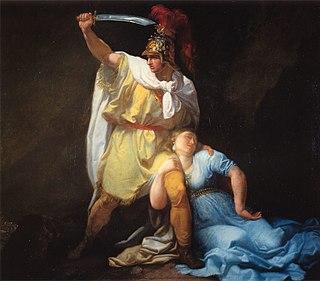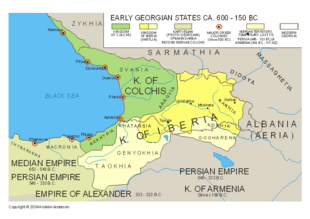
In Greco-Roman geography, Iberia was an exonym for the Georgian kingdom of Kartli, known after its core province, which during Classical Antiquity and the Early Middle Ages was a significant monarchy in the Caucasus, either as an independent state or as a dependent of larger empires, notably the Sassanid and Roman empires. Iberia, centered on present-day Eastern Georgia, was bordered by Colchis in the west, Caucasian Albania in the east and Armenia in the south.

The South Caucasus, also known as Transcaucasia or the Transcaucasus, is a geographical region on the border of Eastern Europe and West Asia, straddling the southern Caucasus Mountains. The South Caucasus roughly corresponds to modern Armenia, Georgia, and Azerbaijan, which are sometimes collectively known as the Caucasian States. The total area of these countries measures about 186,100 square kilometres. The South Caucasus and the North Caucasus together comprise the larger Caucasus geographical region that divides Eurasia.

David IV, also known as David IV the Builder (1073–1125), of the Bagrationi dynasty, was the 5th king (mepe) of the Kingdom of Georgia from 1089 until his death in 1125.

The Battle of Didgori was fought between the armies of the Kingdom of Georgia and the Seljuk Empire at the narrow place of Didgori, 40 km west of Tbilisi, on August 12, 1121. The large Muslim army, under the command of Ilghazi, was unable to maneuver and suffered a devastating defeat due to King David IV of Georgia's effective military tactics.
For articles related to Georgia, see Category:Georgia (country)

Javakheti or Javakhk is a historical province in southern Georgia, corresponding to the modern municipalities of Akhalkalaki, Aspindza (partly), Ninotsminda, and partly to the Turkey's Ardahan Province. Historically, Javakheti's borders were defined by the Kura River (Mtkvari) to the west, and the Shavsheti, Samsari and Nialiskuri mountains to the north, south and east, respectively. The principal economic activities in this region are subsistence agriculture, particularly potatoes and raising livestock.

The Mongol invasions of Georgia, which at that time consisted of Georgia proper, Armenia, and much of the Caucasus, involved multiple invasions and large-scale raids throughout the 13th century. The Mongol Empire first appeared in the Caucasus in 1220 as generals Subutai and Jebe pursued Muhammad II of Khwarezm during the destruction of the Khwarezmian Empire. After a series of raids in which they defeated the combined Georgian and Armenian armies, Subutai and Jebe continued north to invade Kievan Rus'.

The Kingdom of Georgia, also known as the Georgian Empire, was a medieval Eurasian monarchy that was founded in c. 1008 AD. It reached its Golden Age of political and economic strength during the reign of King David IV and King Tamar the Great from the 11th to 13th centuries. Georgia became one of the pre-eminent nations of the Christian East, and its pan-Caucasian empire and network of tributaries stretched from Eastern Europe to Anatolia and northern frontiers of Iran, while Georgia also maintained religious possessions abroad, such as the Monastery of the Cross in Jerusalem and the Monastery of Iviron in Greece. It is the principal historical precursor of present-day Georgia.

The Battle of Baku took place in August and September 1918 between the Ottoman–Azerbaijani coalition forces led by Nuri Pasha and Bolshevik–ARF Baku Soviet forces, later succeeded by the British–Armenian–White Russian forces led by Lionel Dunsterville and saw Soviet Russia briefly re-enter the war. The battle took place during World War I, was a conclusive part of the Caucasus Campaign, but a beginning of the Armenian–Azerbaijani War.

The Iberian–Armenian War was a war for the throne of Armenia between the Kingdom of Iberia and the Armenian Arsacids. It is known chiefly through its description in Tacitus 'Annals.

The history of Tbilisi, the capital of Georgia, dates back to at least the 5th century AD. Since its foundation by the monarch of Georgia's ancient precursor Kingdom of Iberia, Tbilisi has been an important cultural, political and economic center of the Caucasus and served, with intermissions, as the capital of various Georgian kingdoms and republics. Under the Russian rule, from 1801 to 1917 it was called Tiflis and held the seat of the Imperial Viceroy governing both sides of the entire Caucasus.

The German Caucasus expedition was a military expedition sent in late May 1918, by the German Empire to the formerly Russian Transcaucasia during the Caucasus Campaign of World War I. Its prime aim was to stabilize the pro-German Democratic Republic of Georgia and to secure oil supplies for Germany by preventing the Ottoman Empire from gaining access to the oil reserves near Baku on the Absheron Peninsula.
Iran and Georgia have had relations for thousands of years. Eastern and Southern Georgia had been under intermittent Persian suzerainty for many centuries up to the early course of the 19th century, while western Georgia had been under its suzerainty for much shorter periods of time throughout history. Georgia especially rose to importance from the time of the Persian Safavids.

The theme of Iberia was an administrative and military unit (theme) within the Byzantine Empire carved by the Byzantine Emperors out of several Georgian lands in the 11th century. It was formed as a result of Emperor Basil II’s annexation of a portion of the Bagrationi dynasty domains (1000–1021) and later aggrandized at the expense of several Armenian kingdoms acquired by the Byzantines in a piecemeal fashion in the course of the 11th century. The population of the theme—at its largest extent—was multiethnic with a possible Georgian majority, including a sizable Armenian community of Chalcedonic rite to which Byzantines sometimes expanded, as a denominational name, the ethnonym "Iberian", a Graeco-Roman designation of Georgians. The theme ceased to exist in 1074 as a result of the Seljuk invasions.

Foreign relations exist between Armenia and Georgia. Both countries were former Soviet republics of the Soviet Union. Both countries' governments have had generally positive relations, but there have also been some problems.

The nation of Georgia was first unified as a kingdom under the Bagrationi dynasty by the King Bagrat III of Georgia in the early 11th century, arising from a number of predecessor states of the ancient kingdoms of Colchis and Iberia. The Kingdom of Georgia flourished during the 10th to 12th centuries under King David IV the Builder and Queen Tamar the Great, and fell to the Mongol invasion by 1243, and after a brief reunion under George V the Brilliant to the Timurid Empire. By 1490, Georgia was fragmented into a number of petty kingdoms and principalities, which throughout the Early Modern period struggled to maintain their autonomy against Ottoman and Iranian domination until Georgia was finally annexed by the Russian Empire in the 19th century. After a brief period of independence as Democratic Republic of Georgia, the country soon ended up being a Soviet republic until the dissolution of the Soviet Union. The current republic of Georgia has been independent since 1991.

Arab rule in Georgia, natively known as Araboba refers to the period in the History of Georgia when parts of what is now Georgia came under Arab rule, starting with the first Arab incursions in the mid-7th century until the final defeat of the Emirate of Tbilisi at the hands of King David IV in 1122. Compared with other regions which endured Muslim conquests, Georgia's culture, and even political structure was not much affected by the Arab presence, as the people kept their faith, the nobles their fiefdoms, and the foreign rulers mostly insisted on the payment of tribute, which they could not always enforce. Still, repeated invasions and military campaigns by the Arabs devastated Georgia on many occasions, and the Caliphs retained suzerainty over significant parts of the country and exerted influence over the internal power dynamics during most of the period.

The Georgian–Seljuk wars, also known as Georgian Crusade, is a long series of battles and military clashes that took place from c. 1048 until 1213, between the Kingdom of Georgia and the different Seljuqid states that occupied most of Transcaucasia. The conflict is preceded by deadly raids in the Caucasus by the Turks in the 11th century, known in Georgian historiography as the Great Turkish Invasion.
Phasiane is a historical region now part of the Eastern Anatolia region of Turkey, as well as the name given to the region where the Aras River originates.

The 1991–1992 Georgian coup d'état, also known as the Tbilisi War, or the Putsch of 1991–1992, was an internal military conflict that took place in the newly independent Republic of Georgia following the fall of the Soviet Union, from 22 December 1991 to 6 January 1992. The coup, which triggered the Georgian Civil War, pitted factions of the National Guard loyal to President Zviad Gamsakhurdia against several paramilitary organizations unified at the end of 1991 under the leadership of warlords Tengiz Kitovani, Jaba Ioseliani and Tengiz Sigua.

























